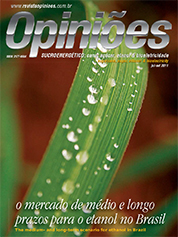Mônika Bergamaschi
Secretary of Agriculture of the State of São Paulo
Op-AA-29
Strategic planning is what is missing
Brazilian ethanol has experienced extraordinary growth, setting records not only in production, but also in terms of demand, especially in the domestic market that consumes more than 85% of total production. Flex-fuel vehicles boosted the industry, by providing sustainability to growth in the product’s supply and the setting up of new plants until 2008.
With the world crisis, credit became scarce and, in combination with debt resulting from high investments and low prices of previous years, the concentration process in the industry escalated.
However, the most recent revision of the projections for the 2011/2012 sugarcane harvest, done by UNICA and CTC, indicate the crushing in the Center-Southern region of 533.5 million tons, about 6.6% less than the estimate of last March, and a decrease of 4.2% in relation to the total crushed in the 2010/2011 harvest.
Several factors contributed to this reduction, such as the advanced age of the plantations, less new plantations and less renewal areas. Furthermore, cultivated areas were technologically less endowed in the cultivation of ratoons. As a result, a decrease in productivity.
Problems did not stop there. Induced flowering, in combination with several factors such as temperature, time of photosynthesis and humidity, which occurred in production regions in the states of SP, MG and GO, reduced the concentration of sugar in the culms and plants’ industrial productivity.
In addition, some sugarcane producing regions in the states of SP, MS and PR also suffered from frost effects in June. The challenge that remains is to accelerate the renewal of exhausted sugarcane plantations and to resume the recovery of those
still responsive, essentially to cultivation and fertilization, so as to revitalize the plantations.
Specifically, we are left with the actual rise in production costs and the foreign exchange policy that reduces industry exports’ competitive capacity. Relatively conservative projections indicate that the demand for Brazilian ethanol in 2020 will be at about 60 to 65 billion liters. To get there, Brazil’s sugarcane plantation areas need to increase from currently 8.6 million hectares (1% of the country’s territory), to 12 million hectares.
One should point out that the industry’s agro-environmental zoning shows that Brazil has more than 64 million hectares suited for cultivation, without having to deforest and while expanding to generally under-utilized and degraded grazing areas, which amounts to an area eight times bigger than the one currently used for sugarcane plantations.
Research and sugarcane’s genetic improvement have greatly contributed to the increase in productivity (average of 1.5% per year). Actually, this is a field in which traditionally private initiative and the government have cooperated, with excellent results.
From the industrial point of view, Brazil masters the technology, both for the production of ethanol and of flexfuel vehicles. However, given that the demand for ethanol will exceed that of sugar, the country will require installed industrial capacity of about 70 to 75% for ethanol production and of 25 to 30% for sugar.
All this requires investment and investors, and the good news is that they exist, they are available and willing. What is missing is strategic planning. Neither the government nor the private sector have defined a consistent development plan for the sugarcane-based energy industry.
As long as this does not exist and as long as ethanol is not a commodity, traded in securities exchanges, with futures’ contracts, newcomer ethanol consumers will lack the security needed to celebrate medium- or long-term contracts. They would be the dynamo to bring about a new investment cycle in the industry.
Another bottleneck for ethanol exports is logistics infrastructure for transportation from production regions to terminals, storage facilities, and ports. Even if surpluses were available in the domestic market and if the United States and other important international consumers were to open their markets for Brazilian ethanol, we would be unable to take advantage of such an opportunity in the short- to medium-term, since the current export capacity is limited to less than five billion liters/year.
Substantial investments are required and an alternative may well be PPPs (Public Private Partnerships), inclusively with the participation of some of the major oil and trading companies, which are taking initial steps to getting involved in the industry.
ANP (the national oil, natural gas and biofuels agency) could substantially contribute to regulating protocols, warranting compliance of goals and standards, while also equalizing the supply and demand curve, more rapidly adjusting speed and efficacy of the addition of anhydrous ethanol to gasoline, minimizing drastic price oscillations, due to reasons of seasonality and marketing. So, rather than the country try to predict the future of Brazilian ethanol, the best to do is to roll up one’s sleeves and help build it up!




